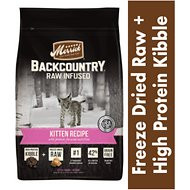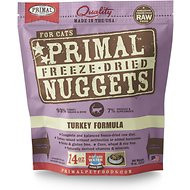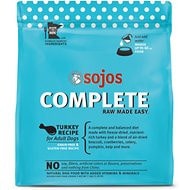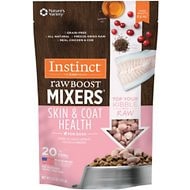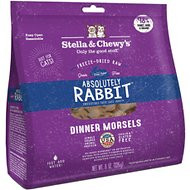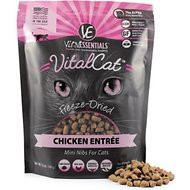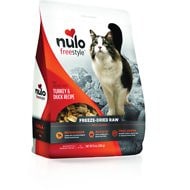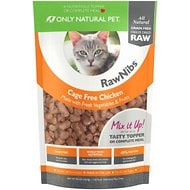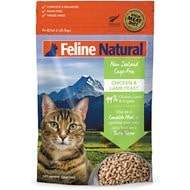Contents
- What Is The Best Freeze-Dried Cat Food?
- What is Freeze-Dried Cat Food, Anyway?
- Tips for Feeding Your Cat Freeze-Dried Food
- Special Considerations with Freeze Dried Cat Food
- What Should You Look for in a Good Cat Food?
- How Do We Make Cat Food Recommendations?
- The 9 Best Freeze Dried Cat Foods
- 4 More Top-Rated Freeze Dried Cat Foods
- Frequently Asked Questions
When you picture an astronaut in outer space, what comes to mind? Aside from the space suit and the floating around the shuttle, you might think about freeze dried food. Freeze drying makes it possible to preserve food so it can easily be transported into space while minimizing the weight.
Your cat isn’t going into space anytime soon, but he could still enjoy freeze dried food. This type of food offers a longer shelf life than the typical dry diet, but it can also be more nutritious.
In this article, we’ll talk about freeze dried cat food including how it’s made, its benefits, and special considerations to make before choosing this type of diet. You’ll also learn what you need to look for in a freeze dried diet and see our top picks for the best freeze dried cat food.
What Is The Best Freeze-Dried Cat Food?
- Primal Freeze Dried Cat Food
- Sojos Complete Turkey Grain-Free
- Merrick Backcountry Raw Infused
- Instinct by Nature’s Variety Freeze Dried
- Stella & Chewy’s Absolutely Rabbit Dinner
- Vital Essentials Chicken Mini Nibs Entrée
- Nulo Freestyle Turkey & Duck Recipe
- Only Natural Pet RawNibs Chicken Grain-Free
- Feline Natural Chicken & Lamb Feast Grain-Free
What is Freeze-Dried Cat Food, Anyway?
The idea behind freeze dried cat food is to create a nutritious, high-meat, dry diet that retains more nutritional value than traditional dry food. Freeze drying is a process that involves a combination of drying and pressure. The food is mixed then quickly frozen to lock in nutrients. From there, it is placed in a vacuum seal and exposed to high pressure. This evaporates the frozen water in the food during a process known as sublimation. What’s left is the same ingredients but they are almost completely dry.
Here are some of the benefits of freeze dried food:
- Similar flavor to fresh pet food
- Higher nutrient retention that foods exposed to high heat
- Longer shelf life than the average kibble
- Preserved enzymes and biologically active cultures
- No need for refrigeration (except once rehydrated)
- Smaller volume of food required to deliver calories and nutrition
Remember, freeze dried food is still a commercial cat food, so you need to evaluate the quality of any product before you give it to your cat. You’ll also need to follow the feeding instructions on the package.
Tips for Feeding Your Cat Freeze-Dried Food
Freeze-dried cat food tends to be higher in protein than the average kibble or canned food which makes it a healthy choice for cats. The freeze-drying process preserves much of the nutritional integrity of the raw ingredients, but it also removes the water content of the food. This is of particular concern for cats since they don’t tend to drink as much water as dogs.
The key to including freeze-dried food in your cat’s diet is to properly rehydrate it before feeding. Most packages will include simple instructions for doing this, but here’s an overview:
- Place the appropriate serving of freeze-dried food in your cat’s bowl (ideally stainless steel).
- Break larger pieces of food into small pieces to maximize rehydration.
- Add 1 tablespoon liquid for every ounce of food (you can use water or try bone broth for an added boost of nutrition).
- Stir the liquid and the food together, mixing until all of the pieces are soaked.
- Offer the food to your cat and remove/discard uneaten portions within 1 to 2 hours.
If you like the nutritional benefits of freeze-dried food but it doesn’t really fit your budget, you can add some freeze dried cat treats to his diet. These add a boost of protein and flavor to your cat’s diet without putting too heavy a burden on your wallet.
Special Considerations with Freeze Dried Cat Food
What many cat owners love about freeze-dried pet food is the fact that it is shelf-stable much longer than canned food but offers a similar nutrient profile. This isn’t to say, however, that it doesn’t have some of the same concerns as dry food when it comes to storage and freshness.
Because freeze-dried food isn’t subjected to the same high heat processing as kibble and canned food, it retains more of its nutritional value. That being said, you still need to pay attention to the ingredients themselves. Added fats like fish oil and salmon oil start to oxidize after a package of pet food is opened, so they really only remain fresh for 2 to 3 weeks. This is the same for kibble, but the benefit is that freeze-dried food may have an even longer shelf life than dry food until opened.
The key to keeping freeze-dried food fresh is to keep it in the original packaging. Transferring it to a plastic container may cause it to spoil more quickly. Once you hydrate the food, it should be treated like fresh food and used within 3 but no more than 5 days. You should also avoid leaving rehydrated freeze dried food out for more than an hour or two.
What Should You Look for in a Good Cat Food?
When shopping for cat food, the most important thing to remember is that your cat is a true carnivore or an obligate carnivore. This means his body is biologically adapted to digesting and absorbing nutrition from animal foods. Cats simply aren’t designed to process carbohydrates and, without enough protein in their diet, their bodies will actually start breaking down their own muscle and tissues.
Protein is the foundation of any healthy diet for cats and the Association of American Feed Control Officials (AAFCO) recommends a minimum of 30% for kittens and 26% for adults, calculated on a dry matter basis. This is important to remember because freeze-dried cat food is very low in moisture. Use an online dry matter calculator to plug in the moisture and protein content to find the true amount. Those 26% and 30% values are absolute minimums – your cat will benefit from closer to 40%.
In addition to protein, your cat needs healthy fats to provide energy and to help him absorb fat-soluble vitamins. Again, carbohydrates are not a necessary part of your cat’s diet but in commercial foods they can add fiber and key nutrients.
Here are some other general things to look for in a good cat food:
- Real animal protein as the first ingredient. Real meat, poultry, or fish should be the first ingredient and, ideally, two out of the first three.
- No unnamed meats or meat meals. Make sure the protein in your cat’s food comes from named animal sources. Generic meats and meat meals like poultry or meat by-products should be avoided in favor of named ingredients like chicken or beef meal.
- Healthy animal-based fats. Animal-based fats are a more biologically valuable source, so look for a recipe with an animal-based fat like chicken fat as the primary source.
- Digestible carbohydrates and low-starch veggies. Try to limit the carbohydrate content of your cat’s diet to 10% and look for digestible sources like whole grains and low-starch veggies.
- No artificial colors, flavors, or preservatives. These ingredients do nothing but improve the appearance of cat food from a human perspective – they don’t benefit your cat in any way.
- Limited use of synthetic supplements. Vitamin and mineral supplements are often necessary to ensure nutritional balance in commercial pet food but try to avoid those with too many added amino acids. This usually indicates poor quality in the meat, plus free amino acids are much less biologically valuable to cats than natural animal sources.
Now that you know what to look for in a high-quality cat food in general, you’re ready to start shopping for freeze-dried food! Before you do, however, we want to tell you how we make our cat food recommendations so you know whether you can trust the picks we’ve reviewed in depth below.
How Do We Make Cat Food Recommendations?
We want you to know that we’d never recommend something to you that we wouldn’t feed our own cats. That being said, we recognize that every cat is different and cat owners have different preferences. We’ve done our best to give you the background information you need to understand freeze dried food and to determine whether it’s the best option for your cat. Before getting to the picks, take a quick look at how we evaluate cat foods before giving them a recommendation.
Here are some general requirements for a cat food recipe to receive our stamp of approval:
- A source of high-quality animal protein as the first ingredient
- At least 30% crude protein for kittens and at least 26% for adults
- A minimum of 9% crude fat for kittens and adults
- A balance of omega-3 and omega-6 fatty acids, primarily from animal sources
- A rich blend of nutrients from natural sources and supplements, as needed
- Limited carbohydrate content from digestible sources (like whole grains and veggies)
- No low-quality fillers, by-products, or artificial additives (preservatives, dyes, or flavors)
The 9 Best Freeze Dried Cat Foods
Most of the freeze dried cat foods on the market are objectively higher in quality than the average kibble or canned food. That being said, you still need to do your job as a responsible pet owner and evaluate the quality of the product for yourself before you buy. To help you get started on the right track, we’ve assembled a list of products we recommend:
| Our 2024 Picks: Best Freeze Dried Cat Food | |||
Primal Freeze Dried Cat Food
|
CHECK PRICE | ||
Sojos Complete Turkey Grain-Free
|
CHECK PRICE | ||
Merrick Backcountry Raw Infused Kitten Food
|
CHECK PRICE | ||
Instinct by Nature’s Variety Freeze Dried
|
CHECK PRICE | ||
Stella & Chewy’s Absolutely Rabbit Dinner
|
CHECK PRICE | ||
Vital Essentials Chicken Mini Nibs
|
CHECK PRICE | ||
Nulo Freestyle Turkey & Duck
|
CHECK PRICE | ||
Only Natural Pet RawNibs Chicken
|
CHECK PRICE | ||
Feline Natural Chicken & Lamb Feast
|
CHECK PRICE | ||
Primal Freeze Dried Cat Food
Our Top Overall Pick: Available in a variety of protein options, Primal freeze dried cat food nuggets are an excellent option and easily one of the most popular on the market. This particular recipe features 93% turkey, organs, and bone with 7% produce and supplements. The turkey is raised without antibiotics and added hormones, and the entire recipe is gluten-free and grain-free. What we really love is that most of the vitamins and minerals come from natural sources like fruits and vegetables – there are very few synthetic supplements. This recipe contains a dry matter protein content over 58%.
Sojos Complete Turkey Grain-Free Freeze Dried Raw
Most Affordable Freeze Dried Cat Food: Freeze dried cat food can get expensive fast, but you don’t necessarily need to bankrupt yourself to feed your cat well. This Sojos Complete recipe with freeze dried turkey is a fairly affordable option, priced under $1.00 per ounce. The average cat will eat about ½ cup per day (before being rehydrate with water) and each 1-pound bag contains about 5 cups of dry food. This recipe contains a very limited list of ingredients including USDA turkey, sweet potato and whole egg along with a few fruits and vegetables. There are only four synthetic supplements needed for complete nutrition.
Merrick Backcountry Raw Infused Kitten Food
Best Freeze Dried Kitten Food: Though not exclusively a freeze dried formula, this Merrick Backcountry kitten food is still a good option. It features high-protein kibble infused with freeze-dried draw bites of chicken for a boost of protein and flavor. This recipe contains several protein sources, three of which make up the first three ingredients, along with natural sources for key nutrients and supplements as needed. Measured on a dry matter basis, this recipe contains a minimum of 47% protein which isn’t quite as high as some freeze dried recipes but is still more than enough to meet your kitten’s needs for healthy growth and development.
Instinct by Nature’s Variety Freeze Dried Raw Boost Mixers
Best Freeze Dried Cat Food Mixer: Freeze dried cat food isn’t always affordable as an exclusive diet, but you can still give your cat the nutritional benefits by adding a meal mixer to his regular diet. This freeze dried raw boost formula from Instinct by Nature’s Variety is a great option. It features real chicken and cod as the primary ingredients with other recipes designed to support skin and coat health. It includes ground bone as a natural source of minerals and joint-supporting nutrients as well as flaxseed for healthy fat and fiber. This product is only intended for supplemental feeding, so don’t use it as your cat’s staple diet.
Stella & Chewy’s Absolutely Rabbit Dinner Morsels Freeze Dried Cat Food
Best Freeze Dried Cat Food for Sensitive Stomach: If your cat has food allergies or a sensitive stomach, you may want to consider a limited ingredient diet made with a single source of novel protein. This Absolutely Rabbit recipe from Stella & Chewy features rabbit with ground bone as the only source of protein – one that is novel for most cats. It also contains a limited number of main ingredients, though it does contain some synthetic vitamins and minerals. This recipe is supplemented with dried fermentation products for healthy digestion, but it’s unclear how many microorganisms really survive the freeze-drying process.
4 More Top-Rated Freeze Dried Cat Foods
Vital Essentials Chicken Mini Nibs Entrée Freeze-Dried Cat Food
Another option in limited ingredient freeze dried food is this Vital Essentials Chicken Mini Nibs Entrée. This recipe features whole meat, organs, and bones with an extremely short list of main ingredients. Ground chicken with bone is the first ingredient, followed by chicken heart, chicken liver, and chicken gizzard. You’ll also note that this recipe contains raw goat’s milk as a digestive aid. This recipe contains no synthetic supplements and it is extremely high in protein – nearly 50% dry matter minimum.
Nulo Freestyle Turkey & Duck Recipe Freeze Dried Raw Food
A fairly new addition to Nulo’s Freestyle lineup is this Nulo Freestyle Turkey & Duck Recipe freeze dried raw food. It features turkey and duck as the main ingredients, making it a good choice for cats with allergies to common proteins like chicken and beef. It contains several organ meats as well as fresh meat and bone, plus fresh spinach and cranberries as natural sources for key nutrients. It does contain some synthetic vitamins and minerals, but it also contains probiotics which may help boost digestion.
Only Natural Pet RawNibs Chicken Grain-Free Freeze Dried Food
This Only Natural Pet RawNibs Chicken recipe can be used as a balanced meal or a meal topper. It features cage-free chicken as the main ingredient with fresh vegetables and fruits for balanced nutrition. This recipe contains 100% human grade ingredients with raw organic goat’s milk and raw apple cider vinegar. Both of these ingredients support your cat’s digestive health. This recipe doesn’t contain any synthetic vitamins or minerals and it contains about 48% protein by dry matter calculation.
Feline Natural Chicken & Lamb Feast Grain-Free Freeze Dried Cat Food
Made with 99% chicken, lamb, and organs, this Feline Natural Chicken & Lamb Feast is full of protein and real meat flavor. Flaxseed provides a source of healthy fats and fiber while New Zealand green mussels add joint-supporting glucosamine and chondroitin. This recipe does contain added taurine, an essential amino acid, which brings into question the quality of the proteins, but overall it is a decent recipe. The dry matter protein content is about 52%.
Frequently Asked Questions
- Can freeze-dried cat food be made with raw ingredients? Yes. In fact, most freeze dried cat foods on the market are made with raw ingredients. The freeze-drying process negates the need for high heat processing and retains more of the nutritional integrity of the raw ingredients. In this way, freeze dried cat food offers similar nutritional benefits to fresh food which is often cooked at lower temperatures than dry and canned food.
- Do you have to add water to freeze-dried cat food? It is highly recommended that you rehydrate freeze dried food before offering it to your cat, but you don’t necessarily need to use water. Chicken or beef broth is a more flavorful alternative, though bone broth is best if you want to add nutrients. Raw goat milk is another option, as recommended with Primal freeze dried cat food.
- Does freeze-drying kill bacteria? In order for pet food to be sold in the United States, it must meet certain FDA and USDA requirements for safety. Freeze-dried cat food is held to the same standards, though individual companies follow higher standards than the bare minimum. It’s important to remember that freeze drying doesn’t kill all of the bacteria, though it will kill most. You still need to handle freeze dried raw food with the same safety measures as you would typical raw food.
- How much freeze-dried food should I feed my cat? The amount you feed your cat will depend on his age and body weight as well as his activity level. Refer to the feeding instructions on the freeze dried cat food label and make adjustments to his diet as needed. It’s usually better to err on the side of underfeeding and increase your cat’s ration if he starts to lose weight or has low energy.
- How often should I feed my cat? Most cats do well on two meals a day, though you can add a third meal for kittens and very active younger cats. Just remember that most cat food labels list the total daily feeding recommendations – you’ll need to divide that amount in half for two meals.
Your cat deserves the highest quality nutrition you can give him, but you also need to think about your own convenience. Fresh and raw foods are great, but they simply aren’t practical for many cat owners. If you’re looking for a better option with similar nutritional value, consider freeze dried cat food.
When shopping for freeze dried food, it’s important to evaluate the quality of the product before you buy. High protein content is a must, and you should check for long lists of synthetic supplements. Be wary of added amino acids as well, because their presence may call into question the quality of the proteins which is supposed to be the foundation of the diet.
If you’re not sure where to start shopping, follow our recommendations and try one of the recipes we’ve reviewed above.

